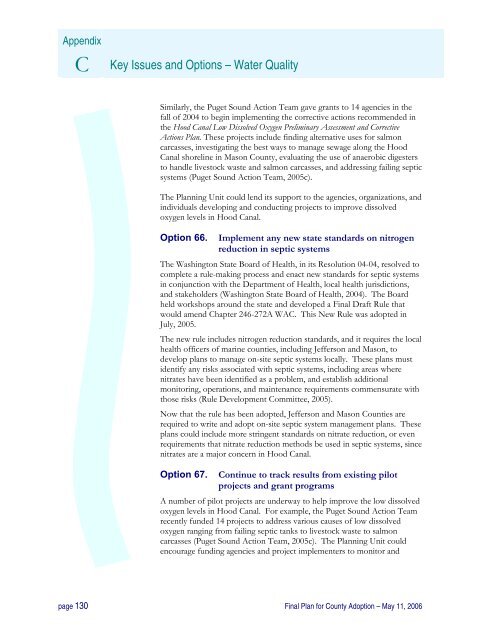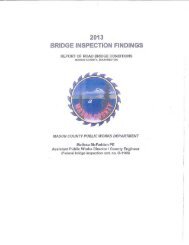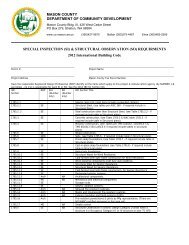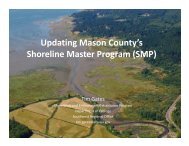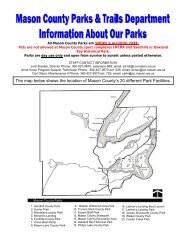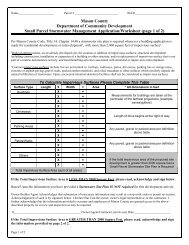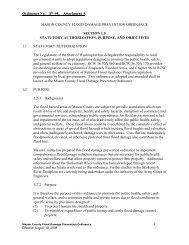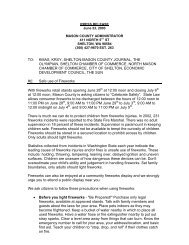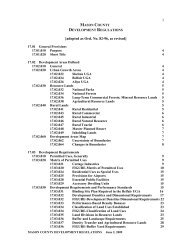Watershed Management Plan - Mason County
Watershed Management Plan - Mason County
Watershed Management Plan - Mason County
Create successful ePaper yourself
Turn your PDF publications into a flip-book with our unique Google optimized e-Paper software.
Appendix<br />
C Key Issues and Options – Water Quality<br />
Similarly, the Puget Sound Action Team gave grants to 14 agencies in the<br />
fall of 2004 to begin implementing the corrective actions recommended in<br />
the Hood Canal Low Dissolved Oxygen Preliminary Assessment and Corrective<br />
Actions <strong>Plan</strong>. These projects include finding alternative uses for salmon<br />
carcasses, investigating the best ways to manage sewage along the Hood<br />
Canal shoreline in <strong>Mason</strong> <strong>County</strong>, evaluating the use of anaerobic digesters<br />
to handle livestock waste and salmon carcasses, and addressing failing septic<br />
systems (Puget Sound Action Team, 2005c).<br />
The <strong>Plan</strong>ning Unit could lend its support to the agencies, organizations, and<br />
individuals developing and conducting projects to improve dissolved<br />
oxygen levels in Hood Canal.<br />
Option 66.<br />
Implement any new state standards on nitrogen<br />
reduction in septic systems<br />
The Washington State Board of Health, in its Resolution 04-04, resolved to<br />
complete a rule-making process and enact new standards for septic systems<br />
in conjunction with the Department of Health, local health jurisdictions,<br />
and stakeholders (Washington State Board of Health, 2004). The Board<br />
held workshops around the state and developed a Final Draft Rule that<br />
would amend Chapter 246-272A WAC. This New Rule was adopted in<br />
July, 2005.<br />
The new rule includes nitrogen reduction standards, and it requires the local<br />
health officers of marine counties, including Jefferson and <strong>Mason</strong>, to<br />
develop plans to manage on-site septic systems locally. These plans must<br />
identify any risks associated with septic systems, including areas where<br />
nitrates have been identified as a problem, and establish additional<br />
monitoring, operations, and maintenance requirements commensurate with<br />
those risks (Rule Development Committee, 2005).<br />
Now that the rule has been adopted, Jefferson and <strong>Mason</strong> Counties are<br />
required to write and adopt on-site septic system management plans. These<br />
plans could include more stringent standards on nitrate reduction, or even<br />
requirements that nitrate reduction methods be used in septic systems, since<br />
nitrates are a major concern in Hood Canal.<br />
Option 67.<br />
Continue to track results from existing pilot<br />
projects and grant programs<br />
A number of pilot projects are underway to help improve the low dissolved<br />
oxygen levels in Hood Canal. For example, the Puget Sound Action Team<br />
recently funded 14 projects to address various causes of low dissolved<br />
oxygen ranging from failing septic tanks to livestock waste to salmon<br />
carcasses (Puget Sound Action Team, 2005c). The <strong>Plan</strong>ning Unit could<br />
encourage funding agencies and project implementers to monitor and<br />
page 130 Final <strong>Plan</strong> for <strong>County</strong> Adoption – May 11, 2006


